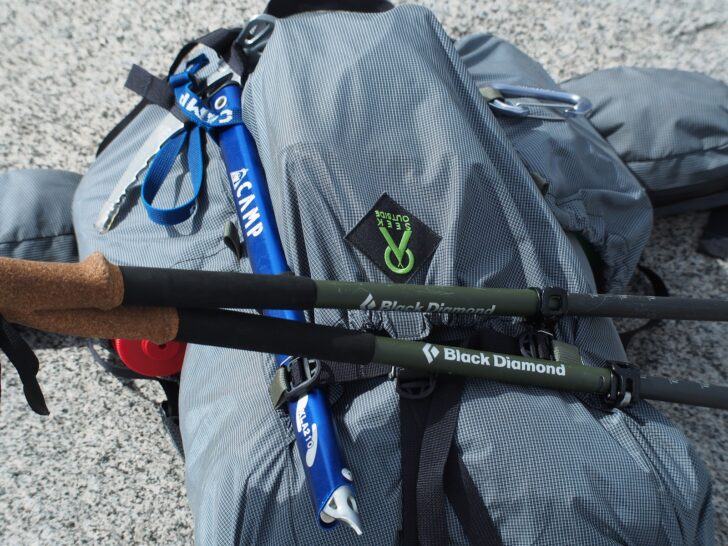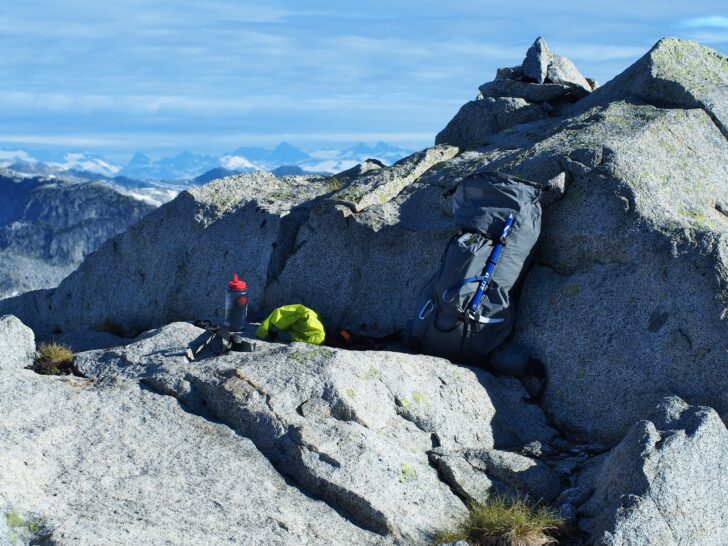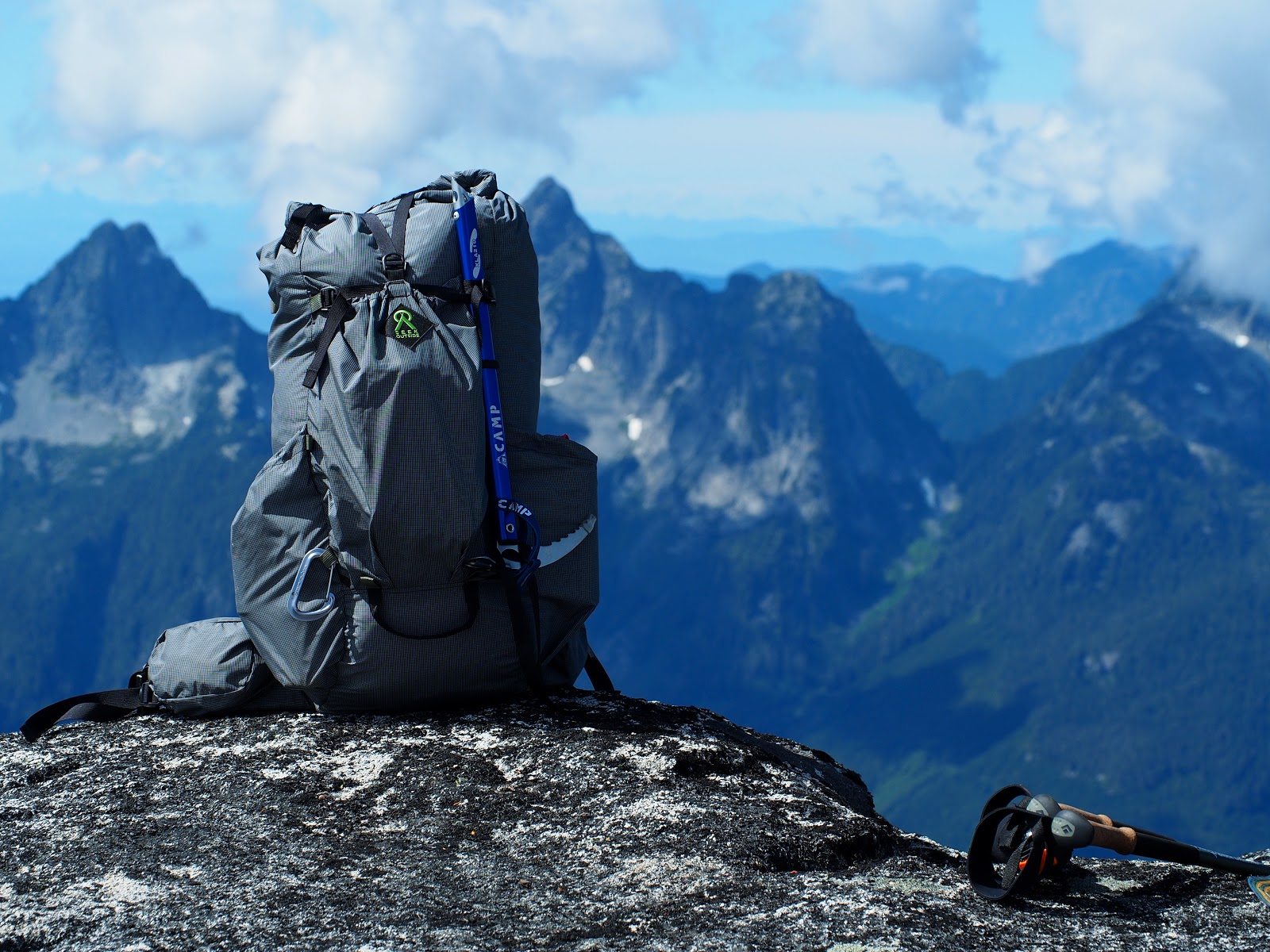Introduction
The Seek Outside Flight One (36 oz/1.02 kg, $319 or $299 for an X-Pac version) is a lightweight, minimalist pack designed with comfort and durability in mind. Seek Outside markets the Flight One not only as a thru-hiking pack but also for more burly and technical adventures. It combines water and abrasion-resistant materials with a streamlined and user-friendly design to create a pack that is worthy of both serious miles and serious loads.

About This Review
This review is based primarily on a five-night alpine trip, including scrambling and glacial travel in the Pacific Northwest. I also used it for multiple-day hikes, overnights, and gear hauls, and all those experiences are reflected in the review.
Features & Specifications
The pack used for this review was made from solid Spectra Grid HT and had a Belt One and 22 in (56 cm) frame. The following specifications are from Seek Outside’s website.
- weight
- 22 in (56 cm) frame – 36 oz | 2 lbs 4 oz (1.02 kg)
- volume
- main pack bag: 3200 cubic inches (52 L)
- front pocket: 534 cubic inches (9 L)
- bottle pockets: fits one 1 L Nalgene or two 1 L Smartwater bottles
- materials
- Spectra Grid HT
- zippered hip-belt pockets
- hydration bladder compatible
- MSRP: $319 (for solid Spectra Grid HT) or $299 (for X-Pac)
Performance Assessment
| Weight | While weight may seem more like a specification than a performance component, it stands out when using the Flight One. The pack is remarkably light when empty, and this makes for really convenient packing and high functionality. This of course also decreases the carry weight of the loaded pack and seems to improve the weight distribution when the pack is filled to different degrees. |
| Durability | The light weight and relatively thin fabrics of the Flight One made me cautious at first. However, this caution gradually dissipated as the pack took unavoidable scraping and bushwacking in stride. After some fairly technical scrambling on rock and ice/snow, the Flight One's materials showed a little abrasion but didn't seem to thin or wear through at all. The simplicity of the pack's structure also makes me hopeful that there will be few points of possible failure, making for a pack with a lot of longevity. NOTE: Seek Outside says that the water-resistance of the full Spectra model will diminish over time but this may be able to be addressed with waterproofing treatments or simply sidestepped with a liner or cover. |
| Padding | Both the hip-belt and the shoulder straps feel well padded. At higher weights, comfort declines as should be expected but the Flight One is capable of a wide variety of loads without undue pain. |
| Adjustability | The Flight One seems to be a fairly fixed pack at first encounter. There are, however, a couple of aspects that let it adapt to different users and different loading. The hip-belt can be adjusted by securing it with some overlap at its fixture point, making for a simple but effective size adjustment that can easily be amended on the fly. Adjustments to the shoulder straps are only made through the standard cinches and load lifters but with the right frame sizing, this doesn't seem to be too limiting. |

Commentary
How does the Seek Outside Flight One stand out?
Backpacks may be tempting to dismiss as a basic piece of equipment with little difference between one and the next. After all, it is just a bag for all of your stuff. As with any piece of equipment though, there are some key advantages to be had by getting the right pack for the job. Different backpacks carry weight differently and organize their contents in different ways.
The Seek Outside Flight One is marketed as a jack-of-all-trades. In essence, the idea of a light pack that is durable and carries weight well presents a lot of possibilities for any given activity but also a slew of different activities.
I had a quick chat with Dennis Poirier at Seek Outside to get a sense of what has gone into making this pack a reality. Seek Outside already had an established line of backpacks before the Flight One was released, so I was curious what inspired them to develop this new pack and what it added to their collection. Dennis highlighted the importance of weight for them in designing and prototyping the Flight One, saying that they were chasing the 2 lbs (0.9 kg) mark throughout the process. He also gave me the interesting tidbit that the name actually was inspired by the desire to have the pack be functional as a carry on for flights. This wasn’t their sole mission, but my impression is that it is just one way to shoot for an adventurous pack that was unobtrusive while also being highly functional. For Dennis, the Flight One stands out by combining Seek Outside’s trademark rugged frames with a lightweight design, making for a very versatile pack. Through using the pack, I have come to the same conclusion and am impressed with their execution.
We should also note that this pack has an extensive Backpacking Light forum thread, complete with a diverse range of reactions and notes. We encourage you to check it out!
The Flight One is a pack that does a number of things very well. It certainly shares some of these characteristics with other available packs, but it executes them very well and stands out on a few fronts:
- Materials
- Space and Weight Carry
- Features
Materials
While other companies use materials that perform similarly to those used in the Flight One, Seek Outside’s implementation, design, and options are noteworthy. The pack used for this review was the full Spectra Grid HT model geared more towards abrasion-resistance than their X-Pac/Spectra model, which claims more permanent water-resistance.
The material used in this pack is a Spectra Grid HT fabric, not unlike Dyneema grid fabrics used by some other manufacturers. This is aimed at abrasion resistance and wear centered on the stronger Spectra fibers woven through a somewhat weaker nylon body. Seek Outside also offers an X-pac/SpectraGridHT option of the Flight One which has greater water resistance but uses the Spectra Grid fabric in high wear areas to improve durability and abrasion resistance.
This being said, the pack was impressively waterproof, holding out moisture during rain showers in the field.

The pack also impressed during a more dramatic pour-over test. I filled the pack with a sleeping quilt and doused it at home. After a few rounds of pouring multiple liters over the pack and giving it some time to sit, the only moisture inside was at the base where it had been sitting in the pooled water. For a proper rainstorm or an extended wet bushwack, the Flight One may not keep its contents bone dry (with the full Spectra Grid HT). Still, users in some environments may well be able to avoid a liner or cover altogether.
The use of a water-resistant material simplifies the pack’s use and provides extra comfort and versatility without requiring the use of either a pack-liner or a cover. Some features of the pack (discussed below) also assure this simplicity by limiting exterior (unprotected) storage and avoiding potential weak points such as zippers or a cinch style opening.
The Seek Outside Flight One shines in combining the water-resistance of its materials with durability. The materials of the pack proved to hold up well to some abuse. Often, waterproof fabrics require some tenderness to hold up to continued use. In assuring that their pack will hold up to heavy use while having functional waterproofing, Seek Outside has made a workhorse of a pack for a variety of occasions.
Space and Weight Carry
A particular strength of the Seek Outside Flight One is that it is light and compressible enough to adapt to a variety of packing styles, from ultralight overnights to longer trips requiring more weight and space. The weight of my particular pack (I chose one without extra straps) is 36.5oz (1.03kg).
Due to the closure, the 60-liter volume of the Flight One may feel smaller than some other 60-liter packs that expand more and include brain storage. This volume, however, still proves to be enough for a broad range of trips. The longest trip done for this review was planned for ten days, and although it was cut short by weather, the Flight One proved to be capable enough for ten days of equipment and supplies (~30 lbs/13.5 kg), including an ice ax and crampons. Through a handful of other shorter trips and gear hauls, the Flight One proved to handle loads up to about 50 lbs (22.5 kg) with relative ease. It is fully possible that this pack could handle bigger loads but at 60-liters, users would likely fill the pack before reaching much larger weights.
I found the hipbelt to be very comfortable. Because I had the pack for a limited time my main use was around 30lbs (23.6kg). I found this weight to ride really nicely on my hips and tighten down onto my shoulders and back well for more technical terrain. Also, it’s important to note that the hip belt is adjustable in length. My iliac crest is about 30 in (76 cm) and I was able to get a snug fit. The more the hip belt is shortened the less velcro overlap there is though, so there could be more risk of sliding or walking on the velcro fixture. That being said, with shorter hikes and load tests I was able to load the pack to about 60lbs (27.2kg) and still carry all of the weight with my hips.
Note that for me the arch of the back panel (providing better airflow) makes a close body fit tricky when heavily loaded while still transferring the majority of the weight to the hips. This may differ for different torso lengths, and the transfer of some weight to the shoulders is still comfortable with the suspension provided. The hipbelt is also fairly soft, allowing it to pivot (as another user pointed out in the comments), this does, however, make heavier loads slightly less stable if transferred to the hips. The hipbelt does twist and sag somewhat with 50lbs+ (22.7kg+) on it. I am personally known to suffer through heavy packs but would say that particularly around the 30lbs (23.6kg) mark this pack is truly comfortable.
Other packs may carry heavy loads better than the Seek Outside Flight One but many of those packs are significantly heavier. The Flight One has a great variety of comfortable carry-weights while not adding much weight itself to your back. It is also fully capable of stretching to higher weight limits if needed, with sacrifices in comfort that generally comes with that. It is designed as simultaneously a minimalist pack and a weight hauler, and I found it to suit this double-duty quite well.
Features
There are a couple of approaches to improving a backpack’s features. Features can either be added in an attempt to increase convenience (more pockets, side access, integrated pack cover, etc.) or they can be stripped down and streamlined to reduce weight and simplify (rolltop, fewer pockets, no zippers, etc.). The Flight One leans more towards the second with a simplistic design. However, I was impressed with the specific features implemented by Seek Outside to make this a very functional pack at an impressively low weight.
The Flight One’s most obvious features are three external pockets: two side pockets that easily fit a 1-liter water bottle fully inside, and one pocket on the rear that can be used for various things from crampons to fuel to wet equipment. The frame and hip-belt come with the standard adjustments and cinches, including load lifters and a sternum strap. The roll-top closure works well, though it requires enough rolls to be completely sealed, and pairs well with the water-resistant materials to seal the contents.

The hip-belt also has two zippered pockets which are a good size to store a number of items for easy access but are not overly cumbersome whether full or empty. These pockets are the only zippers on the pack. The zippers proved to be easy to use and are well made.
Overall, the Seek Outside Flight One’s design makes for a sleek, user-friendly experience as long as you aren’t looking for too many frills. I was impressed with how it performed and liked its simplicity for an efficient packing experience that encourages further minimalism without sacrificing comfort.
Compared To…
Below is a brief comparison of the Seek Outside Flight One to the CiloGear 60 L WorkSack. These packs are both designed with light weight and quality materials in mind. The WorkSack markets itself more towards the alpinist or technical backcountry user but these packs could both be used for similar applications and come from companies with similar intentions in quality, durable, and high-performance packs.
The Seek Outside Flight One vs the CiloGear 60 L WorkSack
| Criteria | Comments | Edge |
|---|---|---|
| Weight | The factory specs are much lower on the Flight One at 2 lbs 4 oz (1.02 kg) compared to the WorkSack at 4.2 lbs (1.98 kg). The WorkSack does strip down some weight, but the Flight One provides more function per weight. | Seek Outside Flight One |
| Weather Resistance | The Flight One uses more water-resistant materials, meaning that for a lot of applications, a pack liner or pack cover could be avoided altogether. The WorkSack materials are rugged but absorb water much more quickly. | Seek Outside Flight One |
| Adaptability | With a detachable lid and a more involved strap system the WorkSack can adapt slightly more to different situations and uses. That being said the Flight One does have better water bottle storage and hip-belt pockets making this a close one depending on what kind of use the pack is going to see. | CiloGear WorkSack |
| Price | The Flight One ranges from $299 to $319 while the WorkSack is listed at $309 making these packs hit essentially the same price point. | Tie: The pricing for both of these packs is similar |
Strengths
- Comfort
- Light and carries a variety of load weights with comfort.
- Ease of Use
- External pockets are all convenient and simplistic.
- Rolltop closure requires little fuss and can compress the pack somewhat.
- Easy to use straps and attachment points make for quick adjustment, compression, and external storage.
- Hipbelt adapts in length with fairly straightforward adjustment.
- Durability
- Material has proven so far to be resilient to abrasion and other stresses.
- Fairly streamlined design limits catching and other possible wear when moving through brush or rubbing against rock.
Limitations
- No brain or pocket which can be detached as a day/peak pack.
- Frame size does not adjust, i.e., the fit must be considered when buying and cannot be hugely adapted (there will still be a range of fit for each frame size).
- The only access is through the top.
- A fairly large frame (i.e., 60 liter-sized) may be unnecessary or even uncomfortable for some with smaller loads.
- The strap system allows for customization but may require some finagling at first.

Where to Buy
Related Content
More by Tully Henke
- Read about Tully’s 90-day self-supported trek across Eastern Russia
- Listen to this episode of The Backpacking Light Podcast, where we talk to Tully about his trek and he shares his experiences with the CiloGear 60 L WorkSack
Reviews
- Check out Drew Smith’s review of the Seek Outside Divide 4500
In the Forum
- Our community had fun discussing the Seek Outside Flight One before it came out. Check out the convo!
DISCLOSURE (Updated April 9, 2024)
- Product mentions in this article are made by the author with no compensation in return. In addition, Backpacking Light does not accept compensation or donated/discounted products in exchange for product mentions or placements in editorial coverage.
- Some (but not all) of the links in this review may be affiliate links. If you click on one of these links and visit one of our affiliate partners (usually a retailer site), and subsequently place an order with that retailer, we receive a commission on your entire order, which varies between 3% and 15% of the purchase price. Affiliate commissions represent less than 15% of Backpacking Light's gross revenue. More than 70% of our revenue comes from Membership Fees. So if you'd really like to support our work, don't buy gear you don't need - support our consumer advocacy work and become a Member instead.
- Learn more about affiliate commissions, influencer marketing, and our consumer advocacy work by reading our article Stop wasting money on gear.




Home › Forums › Seek Outside Flight One Review